|
|
|
Sort Order |
|
|
|
Items / Page
|
|
|
|
|
|
|
| Srl | Item |
| 1 |
ID:
133883


|
|
|
|
|
| Publication |
2014.
|
| Summary/Abstract |
Access to public health care has often been equated with health outcomes. Outcomes-based analysis often misunderstands the process of access to health. This article conceives access to health as a bundled concept and decomposes access into availability, affordability and acceptability. Access to health is determined by public provisioning as well as by socio-economic characteristics of households. It attempts to examine these dimensions across different regions of the Indian state of Uttar Pradesh (UP). It shows that there are variations across regions and socio-economic characteristics of households. A particular group from one region may not have the same degree of access as its counterpart in another region and at the same time there are variations across groups in the same region. The scale of development of regions also plays an important role in promoting or hindering access to health.
|
|
|
|
|
|
|
|
|
|
|
|
|
|
|
|
| 2 |
ID:
105420


|
|
|
| 3 |
ID:
104475


|
|
|
| 4 |
ID:
182937


|
|
|
|
|
| Summary/Abstract |
Many countries in the global South have rapidly aging populations. The COVID-19 pandemic has been especially hard on older adults in these countries, who mainly depend on kin for care. The pandemic has shown that a recommitment to public investment in their well-being is needed.
|
|
|
|
|
|
|
|
|
|
|
|
|
|
|
|
| 5 |
ID:
173729
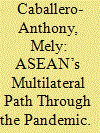

|
|
|
|
|
| Summary/Abstract |
A tradition of multilateral cooperation among the member states of the Association of Southeast Asian Nations (ASEAN) has helped the region effectively respond to the coronavirus pandemic and curtail its spread, after early missteps by some governments. While some nations elsewhere have turned inward and have struggled to cope, ASEAN members were able to mobilize regional mechanisms to coordinate a response. ASEAN has demonstrated the advantages of a rules-based regional order capable of addressing a nontraditional threat to security.
|
|
|
|
|
|
|
|
|
|
|
|
|
|
|
|
| 6 |
ID:
126175
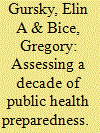

|
|
|
|
|
| Publication |
2012.
|
| Summary/Abstract |
September 11 and the subsequent anthrax attacks marked the beginning of significant investment by the federal government to develop a national public health emergency response capability. Recognizing the importance of the public health sector's contribution to the burgeoning homeland security enterprise, this investment was intended to convey a "dual benefit" by strengthening the overall public health infrastructure while building preparedness capabilities. In many instances, federal funds were used successfully for preparedness activities. For example, electronic health information networks, a Strategic National Stockpile, and increased interagency cooperation have all contributed to creating a more robust and prepared enterprise. Additionally, the knowledge of rarely seen or forgotten pathogens has been regenerated through newly established public health learning consortia, which, too, have strengthened relationships between the practice and academic communities. Balancing traditional public health roles with new preparedness responsibilities heightened public health's visibility, but it also presented significant complexities, including expanded lines of reporting and unremitting inflows of new guidance documents. Currently, a rapidly diminishing public health infrastructure at the state and local levels as a result of federal budget cuts and a poor economy serve as significant barriers to sustaining these nascent federal public health preparedness efforts. Sustaining these improvements will require enhanced coordination, collaboration, and planning across the homeland security enterprise; an infusion of innovation and leadership; and sustained transformative investment for governmental public health.
|
|
|
|
|
|
|
|
|
|
|
|
|
|
|
|
| 7 |
ID:
109718
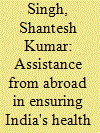

|
|
|
| 8 |
ID:
126033
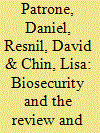

|
|
|
|
|
| Publication |
2012.
|
| Summary/Abstract |
Dual-use research of concern (DURC) is scientific research with significant potential for generating information that could be used to harm national security, the public health, or the environment. Editors responsible for journal policies and publication decisions play a vital role in ensuring that effective safeguards exist to cope with the risks of publishing scientific research with dual-use implications. We conducted an online survey of 127 chief editors of life science journals in 27 countries to examine their attitudes toward and experience with the review and publication of dual-use research of concern. Very few editors (11) had experience with biosecurity review, and no editor in our study reported having ever refused a submission on biosecurity grounds. Most respondents (74.8%) agreed that editors have a responsibility to consider biosecurity risks during the review process, but little consensus existed among editors on how to handle specific issues in the review and publication of research with potential dual-use implications. More work is needed to establish consensus on standards for the review and publication of dual-use research of concern in life science journals.
|
|
|
|
|
|
|
|
|
|
|
|
|
|
|
|
| 9 |
ID:
054156


|
|
|
|
|
| Publication |
Cambridge, Cambridge University Press, 2004.
|
| Description |
xii, 363p.
|
| Standard Number |
0521814723
|
|
|
|
|
|
|
|
|
|
|
|
Copies: C:1/I:0,R:0,Q:0
Circulation
| Accession# | Call# | Current Location | Status | Policy | Location |
| 048717 | 363.3497/URS 048717 | Main | On Shelf | General | |
|
|
|
|
| 10 |
ID:
174201
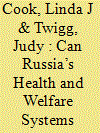

|
|
|
|
|
| Summary/Abstract |
The COVID-19 pandemic has tested the preparedness of Russia’s public health system to respond to a nationwide crisis, and the ability of its broader welfare state to cushion the population against the economic impacts. This essay puts these developments in the context of recent reforms of the health care and welfare systems, showing how they affected the population’s vulnerability to the pandemic’s health and economic shocks, and the government’s ability to manage both.
|
|
|
|
|
|
|
|
|
|
|
|
|
|
|
|
| 11 |
ID:
105135
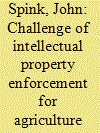

|
|
|
|
|
| Publication |
2011.
|
| Summary/Abstract |
One often-overlooked aspect of intellectual property rights (IPR) strategy is the deterrence and enforcement against 'irresponsible defendants' including product counterfeiters. When applied to food, the consumer product fraud or product counterfeiting is referred to as food fraud, or economically motivated adulteration. While this problem is not unique to agriculture and food products, there are special circumstances and issues to consider. The objectives of this paper are to: (1) review the underlying fraud opportunities (complex and on a massive scale), including an exploration of types of fraudsters and types of fraud (near infinite); (2) review how globalization and source economies contribute to the problem; (3) review the complexity and challenges of enforcement for companies and agencies; and (4) introduce the 'chemistry of the crime' or the 'crime triangle', to shift the focus from reactionary intervention and response to proactive prevention. Five applicable case studies are included, bringing insights on the irresponsible nature of many of the fraudsters. Through its review of fraudsters and types of fraud, this study will provide information to assist with IP technology transfers and the effective enforcement of IPR. Product counterfeiting often poses a very serious public health and economic threat to agriculture and food products. There are very motivated, intelligent, resilient and aggressive fraudsters, but they can be deterred by companies or agencies focused on reducing fraud opportunities. Standard business practices-even identified best practices-often inadvertently contribute to fraud opportunities.
|
|
|
|
|
|
|
|
|
|
|
|
|
|
|
|
| 12 |
ID:
173727


|
|
|
|
|
| Summary/Abstract |
South Korea and Taiwan effectively suppressed the coronavirus without the authoritarian measures imposed in China or the lockdowns used elsewhere. They responded quickly, communicated clearly and consistently about the threat. Both governments had prior experiences with contagions to prepare for an epidemic. And both states had introduced universal health care during their periods of democratization, shaping a consensus among citizens about equity, solidarity, and the role of government in protecting public health. Their strategies provide replicable and repeatable models.
|
|
|
|
|
|
|
|
|
|
|
|
|
|
|
|
| 13 |
ID:
101284
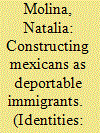

|
|
|
|
|
| Publication |
2010.
|
| Summary/Abstract |
This article draws on archival records of events in California's Imperial Valley in 1940 that resulted in the arrests and deportation of a group of Mexican workers, some of whom were known union activists. The workers had entered the country lawfully and had lived in the United States for years. These immigrants were nevertheless vulnerable because they were receiving treatment for a communicable disease. This, according to immigration officials, rendered them "likely to become a public charge" (LPC), a deportable offense. Officially designating Mexicans as LPCs discredited them at the same time that it circumvented any discussion of possible violation of labor rights or civil rights, both key aspects of government-sponsored reform efforts underway at the time. Constructions of subjects as illegal, diseased, and threats to the nation-state came together in such a way that provided a surefire formula for marking Mexicans as deportable.
|
|
|
|
|
|
|
|
|
|
|
|
|
|
|
|
| 14 |
ID:
181685
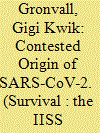

|
|
|
|
|
| Summary/Abstract |
This article describes what is known about the origin of SARS-CoV-2, with implications for policy, biological research and public-health surveillance. Theories about the origin include a natural emergence; a laboratory accident with a naturally harvested strain; an accident with a naturally harvested strain modified in a laboratory; and the deliberate creation of a biological weapon. While available scientific evidence points to a natural zoonotic event as the origin of SARS-CoV-2, this paper recommends specific steps governments and scientific institutions should take to address uncertainties about the origin of the COVID-19 pandemic, as well as to make all potential causes for a pandemic less likely to produce one in the future. Immediate steps include promoting international scientific collaboration, addressing scientific misinformation and disinformation, fully implementing ‘One Health’ and reining in the illegal wildlife trade.
|
|
|
|
|
|
|
|
|
|
|
|
|
|
|
|
| 15 |
ID:
094365
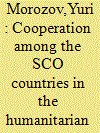

|
|
|
| 16 |
ID:
126005


|
|
|
|
|
| Publication |
2012.
|
| Summary/Abstract |
Rapid public health response to a large-scale anthrax attack would reduce overall morbidity and mortality. However there is uncertainty about the optimal cost effective response strategy based on timing of intervention, public health, resources, and critical care facilities. We connected a decision analytic study to compare response strategies to a theoretical large scale anthrax attack on the Chicago metropolitan area beginning either Day 2 or Day 5 after the attack. These strategies correspond to the policy option set forth by the Anthrax Modeling Working Group for population-wide response to a large scale anthrax attack: (1) postattack antibiotic prophylaxix, (2) postattack antibiotic prophylaxis and vaccination, (3) Preattack vaccination with postattack antibiotic prophylaxis, and (4) preattack vaccination with postattack antibiotic prophylaxis and vaccination.
|
|
|
|
|
|
|
|
|
|
|
|
|
|
|
|
| 17 |
ID:
185658


|
|
|
|
|
| Summary/Abstract |
Like other African nations, Sierra Leone seemed to avoid the worst pandemic scenarios. Its previous experience with Ebola may have led to improved preparedness in the health system. But the government has once again reverted to a militarized response, and elites returning from international travel may pose a risk of spreading the coronavirus. The author also reflects on the challenges of tracking the situation from afar, in the midst of a global crisis, and critically assesses Western media coverage of African public health issues.
|
|
|
|
|
|
|
|
|
|
|
|
|
|
|
|
| 18 |
ID:
175070


|
|
|
|
|
| Summary/Abstract |
South Asia, a poor, densely-populated region with weak public health infrastructure, appears highly vulnerable to COVID-19. But cases and fatalities have so far remained relatively low in the region. The low case-load is unlikely related to climate, malaria exposure or tuberculosis vaccination, as has been suggested. Insufficient testing in South Asian countries has probably disguised the true extent of the outbreak. Younger demographics might also explain the region's low fatality rate. Although the health impact of coronavirus has not been as devastating as some feared, the social, economic and political consequences are already severe. The pandemic is exposing and exacerbating some of the region's major weaknesses, including poverty, gender inequality, persecution of minorities, authoritarian governance, and geopolitical competition. In that sense, coronavirus is both a “mirror”, which reflects South Asia's problems, and a “catalyst”, which intensifies them.
|
|
|
|
|
|
|
|
|
|
|
|
|
|
|
|
| 19 |
ID:
185756


|
|
|
|
|
| Summary/Abstract |
The COVID-19 pandemic has shaken the global economy and the livelihoods of disadvantaged populations. Bangladesh, like other developing countries, has been hit hard, and marginalized groups have suffered the most. Before the pandemic, Bangladesh’s economy was growing rapidly, and the country was known for its steady improvement in health and education development indicators. Yet in its pandemic response, the government has been unable to provide adequate aid and health facilities for the large population living in poverty. The response has been hampered by lack of resources, corruption in the delivery of economic support, and existing health inequalities.
|
|
|
|
|
|
|
|
|
|
|
|
|
|
|
|
| 20 |
ID:
173726


|
|
|
|
|
| Summary/Abstract |
China faced the arrival of COVID-19 armed with new infrastructure, tools, and personnel that it had developed as part of a nationwide overhaul of its public health system in the wake of the 2003 SARS epidemic. The country learned two major lessons from SARS: it needed to increase its scientific professionalism and transparency, and it needed to build upon the successes of its authoritarian disease control capabilities. These two lessons were on full display during China’s COVID-19 response. The goals and methods they implied were sometimes in contradiction with each other, however, and ultimately they failed to prevent a catastrophic pandemic.
|
|
|
|
|
|
|
|
|
|
|
|
|
|
|
|
|
|
|
|
|